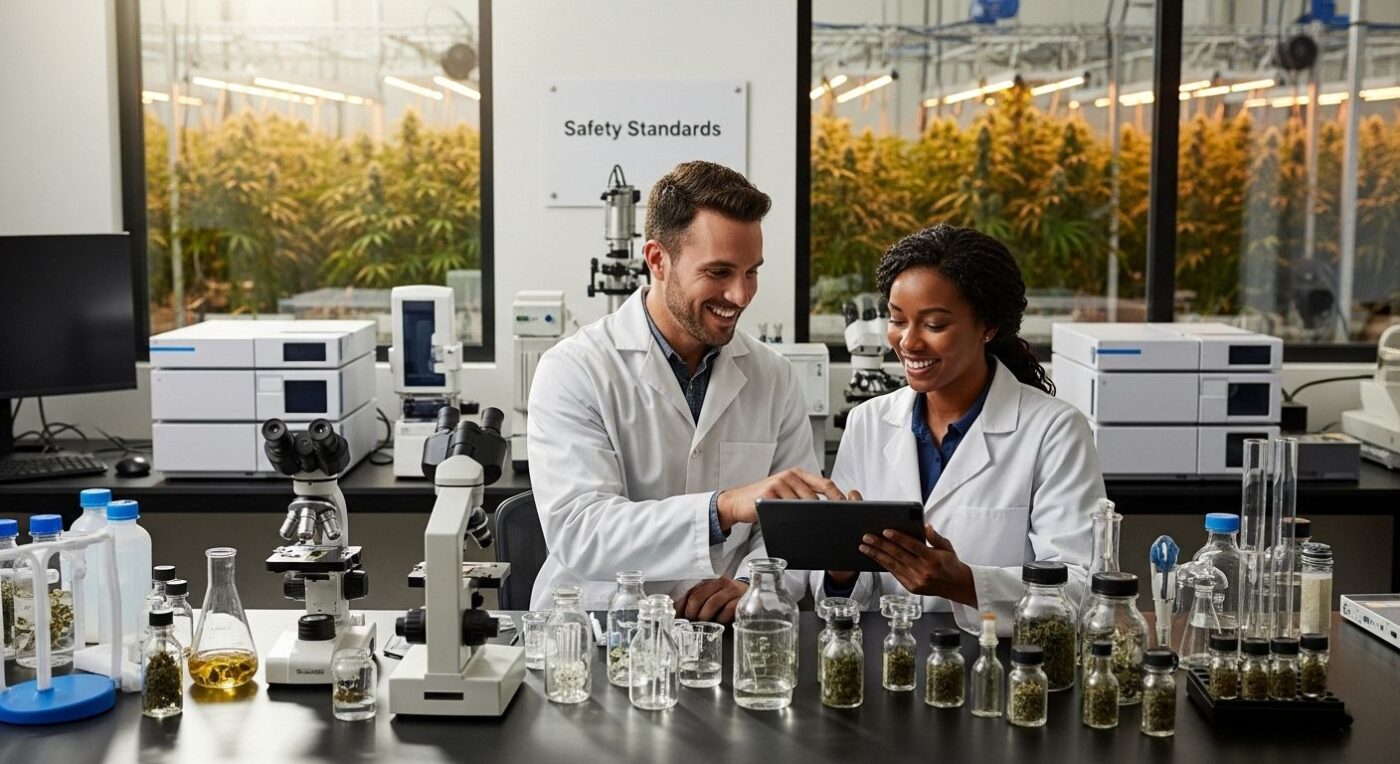Blog
Understanding Why Safety Standards Matter for Cannabis
Cannabis products are showing up everywhere and more people are paying attention to what goes inside these items. Surprisingly, more than 60 percent of products tested in some markets fail basic safety screening for things like contamination or inaccurate labeling. You might expect rigid standards to be the exception but they are quickly becoming the new rule across the entire industry. This shift is changing how companies produce cannabis and how safe every consumer feels picking a product off the shelf.
Table of Contents
- Defining Safety Standards: What Are They?
- The Importance of Safety Standards in Cannabis Products
- How Safety Standards Ensure Quality and Consumer Protection
- Real-World Impact of Safety Standards on the Cannabis Industry
Quick Summary
| Takeaway | Explanation |
|---|---|
| Safety standards protect consumer health. | They eliminate health risks by screening for contaminants and verifying product composition, ensuring safe cannabis consumption. |
| Clear protocols build industry trust. | Rigorous testing and transparent reporting demonstrate commitment to quality, promoting consumer confidence in cannabis products. |
| Standardization ensures product consistency. | Effective manufacturing processes result in reproducible product quality, allowing consumers to expect reliable effects every time. |
| Workplace safety regulations are essential. | Establishing employee consumption guidelines and training helps maintain a safe, operational environment in cannabis businesses. |
| Public health benefits from robust standards. | Stringent quality controls reduce health risks and promote responsible cannabis use, benefitting the broader community. |
Defining Safety Standards: What Are They?
Safety standards represent comprehensive guidelines and protocols designed to protect consumers, workers, and the broader public from potential risks associated with product manufacturing, distribution, and consumption. In the cannabis industry, these standards are particularly critical due to the complex nature of the product and its varied applications.
The Fundamental Purpose of Safety Standards
At their core, safety standards serve as a systematic approach to identifying, evaluating, and mitigating potential hazards. For cannabis products, this means establishing rigorous criteria that ensure product quality, consistency, and consumer protection. According to National Academies of Sciences, Engineering, and Medicine, these standards cover multiple critical dimensions:
- Product Composition: Verifying chemical consistency and purity
- Manufacturing Processes: Ensuring clean and controlled production environments
- Packaging and Labeling: Providing clear consumer information and safety instructions
Comprehensive Safety Evaluation Framework
The safety standards framework goes beyond simple compliance. It represents a holistic approach to product development and consumer protection. The National Institute for Occupational Safety and Health emphasizes that effective safety standards must address multiple potential exposure risks, including chemical, biological, and ergonomic factors.
Key Components of Safety Standards Include:
- Precise chemical testing protocols
- Strict quality control measurements
- Comprehensive documentation of production processes
- Regular third-party verification and auditing
- Transparent reporting mechanisms
Understanding why safety standards matter means recognizing them as more than bureaucratic requirements. They are essential safeguards that protect consumer health, ensure product reliability, and build trust within the cannabis industry. By establishing clear, scientifically validated guidelines, safety standards create a foundation of accountability and transparency that benefits everyone involved in the production and consumption ecosystem.
To help clarify the different aspects of cannabis safety standards, the table below summarizes the core components discussed throughout the article and highlights their specific functions in protecting consumers and building industry credibility.
| Safety Standard Component | Purpose/Function |
|---|---|
| Product Composition Verification | Ensures chemical consistency and purity in cannabis products |
| Manufacturing Process Controls | Maintains clean, controlled production environments for safe products |
| Packaging and Labeling Standards | Provides clear information and safety instructions to consumers |
| Contaminant Screening Protocols | Detects pesticides, heavy metals, microbes, and other health risks |
| Cannabinoid Concentration Testing | Verifies accurate potency and effect predictability |
| Third-Party Lab Testing | Adds credibility through independent safety verification |
| Transparent Reporting | Builds consumer trust via public disclosure of test results |
| Quality Assurance Audits | Supports ongoing consistency and reliability in product batches |
The Importance of Safety Standards in Cannabis Products
Safety standards are not merely regulatory checkboxes but critical protective mechanisms that ensure consumer well-being, product integrity, and industry credibility. In the rapidly evolving cannabis market, these standards represent a fundamental shield against potential health risks and quality inconsistencies.
Protecting Consumer Health and Safety
The cannabis industry faces unique challenges in maintaining product safety due to its complex botanical nature and diverse consumption methods. According to research published in Frontiers in Pharmacology, the absence of uniform safety protocols can expose consumers to significant health risks, including potential contamination and unpredictable potency levels.
Primary Health Protection Mechanisms Include:
- Identifying potential chemical contaminants
- Verifying precise cannabinoid concentration
- Screening for harmful pesticides and microbial agents
- Ensuring consistent product quality
Establishing Industry Credibility and Consumer Trust
Safety standards function as more than protective measures. They serve as critical trust-building mechanisms that legitimize the cannabis industry. By implementing rigorous testing protocols and transparent reporting, manufacturers demonstrate a commitment to consumer well-being that transcends basic regulatory compliance.
Key Trust-Building Elements:
- Comprehensive third-party laboratory testing
- Clear product labeling with detailed composition information
- Consistent and reproducible manufacturing processes
- Public disclosure of safety testing results
- Proactive quality management systems
Beyond immediate consumer protection, safety standards represent a sophisticated approach to product development. They transform cannabis from a potentially risky commodity into a reliable, scientifically validated product category. By prioritizing safety, the industry can continue to destigmatize cannabis, promote responsible consumption, and build long-term consumer confidence in its products and practices.

How Safety Standards Ensure Quality and Consumer Protection
Safety standards are sophisticated quality control mechanisms that transform cannabis products from potentially unpredictable substances into reliable, thoroughly tested consumer goods. These comprehensive protocols create a systematic approach to protecting public health and ensuring product consistency across the cannabis industry.
Comprehensive Contamination Prevention
The primary objective of safety standards is to eliminate potential health risks through meticulous screening and verification processes. According to the FDA, rigorous testing protocols are essential for identifying and mitigating potential health hazards associated with cannabis consumption.
Critical Contamination Screening Processes:
- Detecting heavy metal presence
- Identifying potential pesticide residues
- Screening for harmful microbial agents
- Verifying chemical composition accuracy
- Ensuring biological safety standards
Standardizing Product Quality and Consistency
Safety standards go far beyond basic contamination testing. They establish a framework that ensures reproducible product quality, creating a reliable experience for consumers. This systematic approach involves multiple layers of verification, including:
- Precise cannabinoid concentration measurements
- Consistent extraction methodology
- Uniform manufacturing protocols
- Comprehensive traceability documentation
- Regular quality assurance audits
By implementing these multilayered safety standards, the cannabis industry demonstrates a commitment to transparency and consumer protection. These protocols transform cannabis from a potentially risky product into a scientifically validated, trustworthy consumer good. The result is an ecosystem where consumers can confidently purchase products knowing they have been subjected to rigorous testing and quality control measures that prioritize their health and safety.

Real-World Impact of Safety Standards on the Cannabis Industry
Safety standards represent more than theoretical guidelines. They are transformative mechanisms that fundamentally reshape how cannabis products are developed, manufactured, and consumed. These standards create ripple effects across multiple sectors, influencing everything from workplace protocols to public health strategies.
Workplace Safety and Operational Integrity
The cannabis industry confronts unique challenges in maintaining professional environments. According to the National Safety Council, workplace safety standards are crucial in mitigating risks associated with potential impairment and maintaining operational excellence.
Key Workplace Safety Considerations:
- Establishing clear employee consumption guidelines
- Implementing comprehensive training programs
- Creating standardized impairment detection protocols
- Developing rigorous screening mechanisms
- Ensuring consistent performance expectations
Public Health and Consumer Protection Implications
Safety standards extend far beyond individual workplace environments. They represent a comprehensive approach to protecting broader public health interests. By establishing stringent quality control protocols, the cannabis industry demonstrates its commitment to responsible product development and consumer well-being.
Critical Public Health Impact Areas:
- Reducing potential health risks from contaminated products
- Creating transparent product information systems
- Establishing clear consumption guidelines
- Promoting responsible usage practices
- Supporting evidence-based research and development
These multifaceted safety standards transform the cannabis industry from a potentially unregulated market into a sophisticated, scientifically driven ecosystem. By prioritizing consumer safety, operational integrity, and transparent practices, the industry builds trust and credibility. The result is a more responsible, accountable approach to cannabis production and consumption that protects both individual consumers and society at large.
The following table compares how safety standards impact both workplace safety and public health across the cannabis industry, making it easier to see the broader benefits and operational gains discussed in the article.
| Impact Area | Key Focus Areas | Benefits to Industry and Public |
|---|---|---|
| Workplace Safety | Employee guidelines, training, impairment protocols | Reduces workplace risk, ensures operational continuity |
| Public Health | Product contamination reduction, transparent labeling, responsible use guidelines | Minimizes consumer health risks, enhances community well-being |
Turn Safety Standards Into Unmatched Quality With Ace Ultra Premium
Concerned about inconsistent quality or hidden risks in your cannabis experience? You are not alone. The article highlights how lacking safety standards in cannabis can put your health and trust at risk. Issues like contamination, unreliable potency, or counterfeit products cause real uncertainty for consumers. You deserve confidence knowing every vape you enjoy is thoroughly lab-tested and authentically verified.
Discover the proof behind our premium safety and quality

Take control now and elevate your cannabis standards. Visit Ace Ultra Premium to see detailed lab reports, advanced authentication features, and transparent product descriptions for every vape disposable. Experience our reliable quality. Check out our selection and embrace cannabis products built for your peace of mind today.
Frequently Asked Questions
What are safety standards in the cannabis industry?
Safety standards are comprehensive guidelines and protocols aimed at protecting consumers and workers from potential risks associated with cannabis products. They ensure product quality, consistency, and consumer safety through rigorous testing and transparency.
Why are safety standards important for consumer health?
Safety standards help identify and mitigate health risks associated with cannabis products, such as contamination and unpredictable potency levels. They protect consumers by ensuring that products are free from harmful chemicals and are accurately labeled regarding their contents.
How do safety standards influence product quality in cannabis?
Safety standards establish systematic protocols for quality control, including precise measurements of cannabinoid concentrations, consistent manufacturing processes, and thorough contamination testing. This ensures that consumers receive reliable and safe products consistently.
What impact do safety standards have on the cannabis industry as a whole?
Safety standards are transformative for the cannabis industry, improving workplace safety, enhancing public health protection, and building consumer trust. They help create a scientifically validated ecosystem, ensuring responsible product development and consumption while minimizing risks to both consumers and society.
Recommended
- ACE ULTRA PREMIUM | THE OFFICIAL WEBSITE
- ACE ULTRA PREMIUM 4G DISPOSABLE – ACE ULTRA PREMIUM
- how many grams is ace ultra premium – ACE ULTRA PREMIUM
- is ace ultra premium delta 8 – ACE ULTRA PREMIUM
Article generated by BabyLoveGrowth

